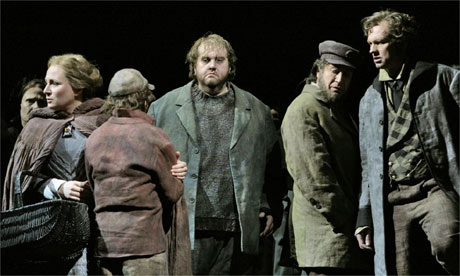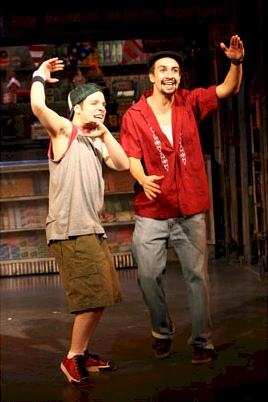Eran Kolirin, The Band’s Visit. This modest, wise, and funny movie plops down a band of Egyptian policeman-musicians in an Israeli nowhere land. Kolirin sidelines explicit political themes in favor of drawing out characters who are, to be sure, shaped by their cultures but not defined by them. Filled with subtle surprises, from the musical passion simmering quietly beneath its characters’ uniforms to the deeper truths that fuel that passion (OGIC).
TT: Almanac
“I have had such a sickening of men in masses, and of causes, that I would not cross this room to reform parliament or prevent the union or to bring about the millennium. I speak only for myself, mind–it is my own truth alone–but man as part of a movement or a crowd is indifferent to me. He is inhuman. And I have nothing to do with nations, or nationalism. The only feelings I have–for what they are–are for men as individuals; my loyalties, such as they may be, are to private persons alone.”
Patrick O’Brian, Master and Commander
BOOK
A.J. Liebling, World War II Writings (Library of America, $40). An omnibus collection of wartime dispatches to The New Yorker, plus twenty-eight previously uncollected articles and Normandy Revisited, the uncommonly elegant 1958 memoir in which Liebling wove together present- and past-tense accounts of his wartime and postwar visits to the site of D-Day. The contents may sound miscellaneous, but in fact they’re magnetically readable. Except for Ernie Pyle, no American journalist did a better job of serving as a witness to war in the twentieth century, and these pieces combine lightness of touch with high seriousness to tremendously powerful effect (TT).
TT: Perpetual motion
 I’m in Cambridge, Massachusetts, and it wasn’t easy getting there, either. Last week I saw Caryl Churchill’s Drunk Enough to Say I Love You? at the Public Theater and Mark Morris’ production of Purcell’s King Arthur at New York City Opera. On Saturday morning I took a train to Philadelphia, where I met Ms. Household Opera for lunch, then took her to the Metropolitan Opera’s high-definition closed-circuit live movie-house telecast of Benjamin Britten’s Peter Grimes, which we viewed in an amusingly pretentious theater. (I’ll be writing about the experience in my next “Sightings” column.)
I’m in Cambridge, Massachusetts, and it wasn’t easy getting there, either. Last week I saw Caryl Churchill’s Drunk Enough to Say I Love You? at the Public Theater and Mark Morris’ production of Purcell’s King Arthur at New York City Opera. On Saturday morning I took a train to Philadelphia, where I met Ms. Household Opera for lunch, then took her to the Metropolitan Opera’s high-definition closed-circuit live movie-house telecast of Benjamin Britten’s Peter Grimes, which we viewed in an amusingly pretentious theater. (I’ll be writing about the experience in my next “Sightings” column.)
 As soon as the show was over, I headed straight to the Philadelphia airport and flew from there to Boston, then drove to Cambridge, where Mrs. T awaited me. Yesterday afternoon the two of us saw the production of The Tempest that I’ll be reviewing in Friday’s Wall Street Journal, then dined at the home of the jewelry designer who made the one-of-a-kind engagement ring that is now to be found on Mrs. T’s finger. Not only is she a fabulous cook, but she has an excellent boyfriend to boot.
As soon as the show was over, I headed straight to the Philadelphia airport and flew from there to Boston, then drove to Cambridge, where Mrs. T awaited me. Yesterday afternoon the two of us saw the production of The Tempest that I’ll be reviewing in Friday’s Wall Street Journal, then dined at the home of the jewelry designer who made the one-of-a-kind engagement ring that is now to be found on Mrs. T’s finger. Not only is she a fabulous cook, but she has an excellent boyfriend to boot.
Later today we’ll be heading back to our hideout in Connecticut, where I plan to spend the week sleeping late and working on Rhythm Man: A Life of Louis Armstrong, which got short shrift while I was preoccupied with my opera workshop. On Thursday we return to New York, on Friday Our Girl in Chicago pays us a house call, and on Saturday the three of us go to Baltimore to see CenterStage’s production of Stephen Sondheim’s A Little Night Music. Whew!
All this incessant activity is likely to slow my blogging for the coming week, but I’ll do what I can, and CAAF and OGIC will do the rest.
See you in passing.
TT: Almanac
“I esteem biography, as giving us what comes near to ourselves, what we can turn to use.”
Samuel Johnson, quoted in James Boswell, Journal of a Tour to the Hebrides (courtesy of Anecdotal Evidence)
TT: A piano, a camcorder, and a competition
The Van Cliburn Foundation has just announced a new competition for amateur pianists, the Cliburn YouTube Contest, whose participants post videos of their piano playing. The winner will receive $2,000 and be automatically entered in the next face-to-face Cliburn Amateur Competition, to be held in 2011. It’s a great gimmick, one that’s bound to attract attention–but will it be good for those pianists who choose to participate? That’s the subject of my latest “Sightings” column in today’s Wall Street Journal. Here’s a sample.
* * *
Fifty years ago next month, a 23-year-old whiz kid from Texas won the Tchaikovsky International Piano Competition in Moscow, instantaneously becoming America’s best-known classical musician and earning a hatful of money in the process. Van Cliburn, then as now a generous man, thereupon started his own piano competition, hoping to give other gifted young artists the same opportunity that the Tchaikovsky Competition had given him. Mr. Cliburn hasn’t played regularly in public since 1978, but the Van Cliburn Competition is still doing business in Fort Worth, and it’s celebrating the anniversary of his Cold War triumph by launching a new venture that would have been unthinkable in 1958: the Cliburn YouTube Contest, in which amateur pianists over the age of 35 shoot videos of their own playing and upload them to the Cliburn Foundation’s YouTube channel, youtube.com/vancliburnfoundation, where computer-savvy music lovers will view them and pick a winner….
So far as I know, the Cliburn YouTube Contest is the first such event of its kind, but the Cliburn Foundation has been holding amateur competitions since 1999. Michael Kimmelman, the New York Times’ senior art critic, was one of the finalists that year, and his participation, not surprisingly, brought the competition a fair amount of press coverage. I expect that the YouTube Contest will have the same effect–as well it should. It is an idea so self-evidently ingenious that your immediate response will probably be to wonder why nobody ever thought of such a thing before.
I have less clear-cut feelings about the Amateur Competition itself, however. Seven years ago I sat on the jury for a jazz piano competition, and came away as dubious about the virtues of artistic competitions as I’d been when I started. Does it really advance the cause of art to treat musicians, painters or novelists as if they were beauty-pageant contestants? Very likely not–but such undertakings will always be with us, for there is something in the nature of head-to-head competition that audiences find inherently exciting. That’s why I agreed to serve as a judge: I thought it my duty to see how the process worked in practice. Yet I still felt equivocal about what I was doing. In a race, somebody always comes in first; in art, nobody does. Why, then, encourage amateurs to put themselves through the wringer of a high-profile competition? Might the experience diminish their passion for the artistic endeavors to which they freely devote such big chunks of their lives?
That Van Cliburn should be lending his name to the YouTube Contest is ironic, for he is one of the saddest examples of the damage that can be done to a serious artist who unexpectedly hits the celebrity jackpot….
* * *
Read the whole thing here.
CAAF: Huzzahs
Terry, OGIC, and I are all big fans of Kate Christensen’s work, so it was thrilling to hear that her most recent novel, The Great Man, has received a well-deserved honor, taking home the 2008 Pen/Faulkner Award for Fiction.
I was also pleased to learn from Galleycat that Sonya Hartnett, author of the phenomenal Thursday’s Child and other novels, has received the Astrid Lindgren Memorial Award for children’s literature. Yay yay!
TT: The slickest show in New York
In today’s Wall Street Journal I review two very different shows, In the Heights and The Seagull. Here’s a sample.
* * *
 The hit of the year is here. “In the Heights,” the Latino musical that tore up Off Broadway last season, has transferred to Broadway in a revised version that is without doubt the slickest show in town. This high-stepping tale of immigrant life in the Upper Manhattan barrio throbs with self-confidence, and its theatrical craftsmanship is gleamingly immaculate. If it’s originality you want, go elsewhere on the double, but if all you require of a musical is an evening of ultra-familiar plot devices buffed to the highest possible gloss and revved up to hypersonic speed, you’re in luck and then some….
The hit of the year is here. “In the Heights,” the Latino musical that tore up Off Broadway last season, has transferred to Broadway in a revised version that is without doubt the slickest show in town. This high-stepping tale of immigrant life in the Upper Manhattan barrio throbs with self-confidence, and its theatrical craftsmanship is gleamingly immaculate. If it’s originality you want, go elsewhere on the double, but if all you require of a musical is an evening of ultra-familiar plot devices buffed to the highest possible gloss and revved up to hypersonic speed, you’re in luck and then some….
If life were fair, Classic Stage Company’s version of Anton Chekhov’s “The Seagull” would move uptown, settle into one of Broadway’s smaller houses, and run for a year. Instead, you have a month to catch it, so don’t wait. It’s been a long time since New York has seen a classical revival comparable in quality or immediacy.
Much of the strength of this engrossing production lies in the fact that it was staged by Viacheslav Dolgachev, who spent a decade as the leading director of the Moscow Art Theatre, the company with which Chekhov’s plays are most closely identified. Yet except for Alan Cumming, who plays Trigorin, everyone in the cast is more or less American, and the play is performed in Paul Schmidt’s clean, colloquial English-language version, which Mr. Schmidt aptly describes as “an American translation, not simply another ‘English’ translation.” The blending of Russian emotionalism with American directness is what gives this “Seagull” its distinctive quality: It sounds American, yet feels Russian….
* * *
Read the whole thing here.
